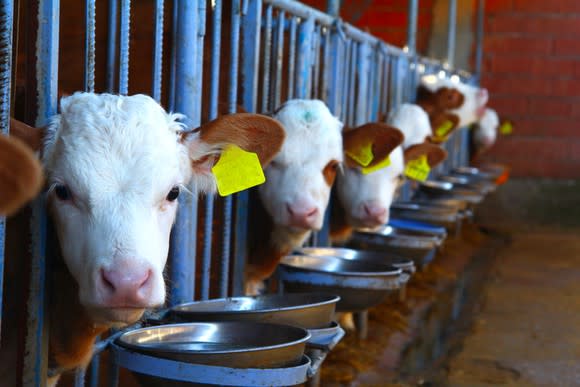This Growth Stock Fell 39.5% in 2017, But Is on Track for a Great 2018
Last year was one to forget for Green Plains (NASDAQ: GPRE) and its shareholders. The leading ethanol stock found the industry's volatility inescapable despite marked progress in ongoing efforts to diversify its business with higher margin assets. So it goes for companies too closely associated with biofuels.
While Wall Street continued to focus on near-term obstacles facing the American ethanol industry instead of considering longer-term opportunities in both ethanol and the company's operations, that could change in the year ahead. What will it take for 2018 to be the year Green Plains finally convinces Mr. Market to properly value its non-ethanol assets?

Image source: Getty Images.
A bad year for ethanol
The American ethanol industry is highly seasonal. The fourth quarter of every year is usually the best for production and gross profit thanks to the cost-saving effects of cold winter air. That's followed by the first quarter of the year, which is the weakest as production facilities are recalibrated and the market draws from the inventory built in the prior quarter. The second and third quarters of the year usually fall somewhere in between depending on factors ranging from corn prices to export demand.
The keyword above is "usually". Green Plains and other American ethanol producers announced surprisingly weak second-quarter earnings last year. A glut of supply amd higher than normal political uncertainty (which impacted subsidy prices) combined to create an unpleasant surprise for Wall Street. The trajectory of ethanol stocks for the remainder of the year was pretty much a wrap after that.
While it's understandable that the (very) negative earnings surprise spooked investors, what's more of a headscratcher is why Wall Street continues to neglect the sweeping diversification efforts made by Green Plains in the last two years.
After a handful of acquisitions, the ethanol leader is now the world's largest producer of vinegar (which is made from ethanol) and the nation's fourth-largest owner of cattle feedlots (which use corn byproducts from the ethanol manufacturing process). The decision to spin off its logistics operations as a master limited partnership has also proven to be a genius move. The food and ingredients segment and ownership stake in the MLP provided just 15% of total revenue through the first nine months of 2017, but 58% of gross profit and 77% of EBITDA.
Wall Street can't possibly ignore performance like that for much longer.

Image source: Getty Images.
Will 2018 be any better?
Well, I expected last year to be good for Green Plains shareholders. That didn't work out so well. Nonetheless, I'm doubling down on my conviction for 2018.
Green Plains turned in a strong performance through the first nine months of 2017 despite several headwinds in the ethanol industry. The important thing for investors to note is that management controlled everything it could. The company continued to focus on growing and expanding its food and ingredients units, while the partnership kept chugging along. Meanwhile, the producer made a move that will not only increase its vertical integration but exploit one of the biggest opportunities in ethanol: exports.
Uncle Sam exported a record volume of ethanol in 2017 and notched the second consecutive year with at least 1 billion gallons of exports. In fact, the nation accomplished both feats by October, and did so after losing one of its most important trading partners (China) from the previous year. Exports are a great opportunity because (1) American ethanol boasts a significant advantage internationally and (2) they insulate producers against volatility in domestic markets.
Green Plains saw the opportunity coming from a mile away. In December it announced the first shipment from an export terminal it owns with Jefferson Energy Companies that may have annual throughput of 100 million gallons. The company's stake in the asset, expected to be purchased by the logistics partnership, will garner business from ethanol producers and refiners alike, allowing the company to both directly and indirectly benefit from the favorable trend in trade.
The company also announced that it will use a special type of corn from Syngenta across its 1.5 billion gallons of annual ethanol production capacity. This didn't attract the attention it deserves, but the development could be a game changer for the industry. Called Enogen, the corn is genetically engineered to produce an enzyme needed in the first stages of ethanol production, but traditionally added in liquid form. The ability to add the enzyme along with the grain (it's technically in the grain) increases ethanol production yield and lowers energy costs. In the volatile and low-margin ethanol industry, every little bit helps.
Investor takeaway
Is Green Plains guaranteed to have a great 2018? Of course not. As with any seasonal industry consisting of entirely commodity products, even small headwinds can cause big headaches. That's the exact reason management invested in diversifying the business with high-margin products that are more or entirely insulated from the volatile ethanol industry. While Wall Street has yet to properly account for the earnings power of the company's non-ethanol assets, that has to change eventually. Maybe 2018 will be the year.
More From The Motley Fool
Maxx Chatsko has no position in any of the stocks mentioned. The Motley Fool has no position in any of the stocks mentioned. The Motley Fool has a disclosure policy.
